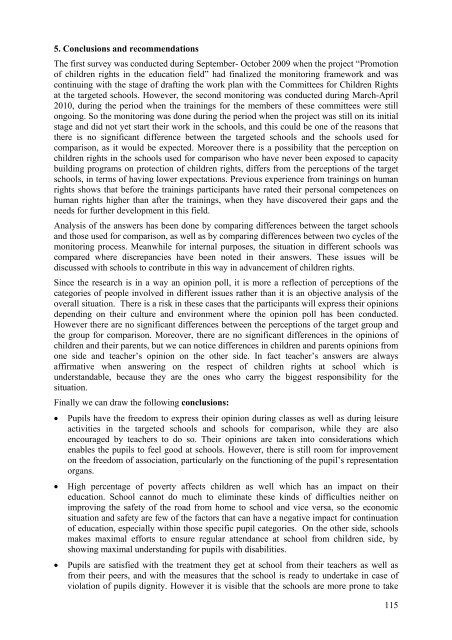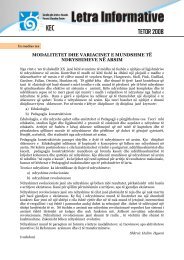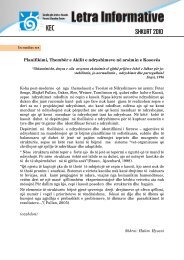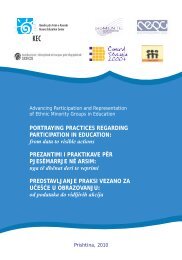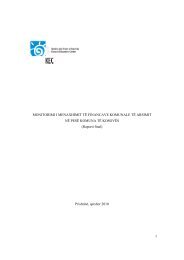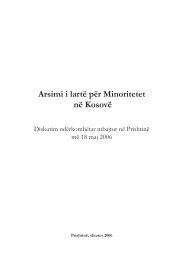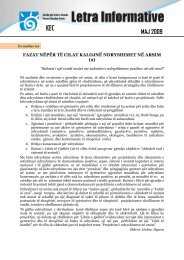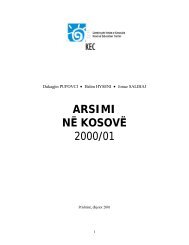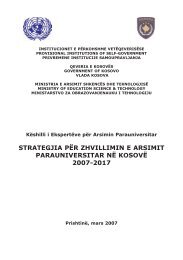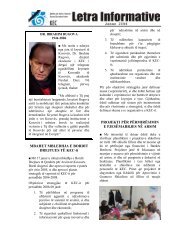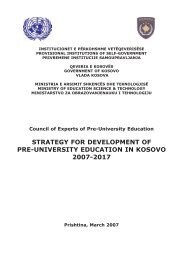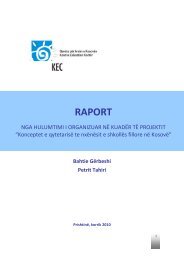Report of the situation of children's rights in the field of education
Report of the situation of children's rights in the field of education
Report of the situation of children's rights in the field of education
Create successful ePaper yourself
Turn your PDF publications into a flip-book with our unique Google optimized e-Paper software.
5. Conclusions and recommendationsThe first survey was conducted dur<strong>in</strong>g September- October 2009 when <strong>the</strong> project “Promotion<strong>of</strong> children <strong>rights</strong> <strong>in</strong> <strong>the</strong> <strong>education</strong> <strong>field</strong>” had f<strong>in</strong>alized <strong>the</strong> monitor<strong>in</strong>g framework and wascont<strong>in</strong>u<strong>in</strong>g with <strong>the</strong> stage <strong>of</strong> draft<strong>in</strong>g <strong>the</strong> work plan with <strong>the</strong> Committees for Children Rightsat <strong>the</strong> targeted schools. However, <strong>the</strong> second monitor<strong>in</strong>g was conducted dur<strong>in</strong>g March-April2010, dur<strong>in</strong>g <strong>the</strong> period when <strong>the</strong> tra<strong>in</strong><strong>in</strong>gs for <strong>the</strong> members <strong>of</strong> <strong>the</strong>se committees were stillongo<strong>in</strong>g. So <strong>the</strong> monitor<strong>in</strong>g was done dur<strong>in</strong>g <strong>the</strong> period when <strong>the</strong> project was still on its <strong>in</strong>itialstage and did not yet start <strong>the</strong>ir work <strong>in</strong> <strong>the</strong> schools, and this could be one <strong>of</strong> <strong>the</strong> reasons that<strong>the</strong>re is no significant difference between <strong>the</strong> targeted schools and <strong>the</strong> schools used forcomparison, as it would be expected. Moreover <strong>the</strong>re is a possibility that <strong>the</strong> perception onchildren <strong>rights</strong> <strong>in</strong> <strong>the</strong> schools used for comparison who have never been exposed to capacitybuild<strong>in</strong>g programs on protection <strong>of</strong> children <strong>rights</strong>, differs from <strong>the</strong> perceptions <strong>of</strong> <strong>the</strong> targetschools, <strong>in</strong> terms <strong>of</strong> hav<strong>in</strong>g lower expectations. Previous experience from tra<strong>in</strong><strong>in</strong>gs on human<strong>rights</strong> shows that before <strong>the</strong> tra<strong>in</strong><strong>in</strong>gs participants have rated <strong>the</strong>ir personal competences onhuman <strong>rights</strong> higher than after <strong>the</strong> tra<strong>in</strong><strong>in</strong>gs, when <strong>the</strong>y have discovered <strong>the</strong>ir gaps and <strong>the</strong>needs for fur<strong>the</strong>r development <strong>in</strong> this <strong>field</strong>.Analysis <strong>of</strong> <strong>the</strong> answers has been done by compar<strong>in</strong>g differences between <strong>the</strong> target schoolsand those used for comparison, as well as by compar<strong>in</strong>g differences between two cycles <strong>of</strong> <strong>the</strong>monitor<strong>in</strong>g process. Meanwhile for <strong>in</strong>ternal purposes, <strong>the</strong> <strong>situation</strong> <strong>in</strong> different schools wascompared where discrepancies have been noted <strong>in</strong> <strong>the</strong>ir answers. These issues will bediscussed with schools to contribute <strong>in</strong> this way <strong>in</strong> advancement <strong>of</strong> children <strong>rights</strong>.S<strong>in</strong>ce <strong>the</strong> research is <strong>in</strong> a way an op<strong>in</strong>ion poll, it is more a reflection <strong>of</strong> perceptions <strong>of</strong> <strong>the</strong>categories <strong>of</strong> people <strong>in</strong>volved <strong>in</strong> different issues ra<strong>the</strong>r than it is an objective analysis <strong>of</strong> <strong>the</strong>overall <strong>situation</strong>. There is a risk <strong>in</strong> <strong>the</strong>se cases that <strong>the</strong> participants will express <strong>the</strong>ir op<strong>in</strong>ionsdepend<strong>in</strong>g on <strong>the</strong>ir culture and environment where <strong>the</strong> op<strong>in</strong>ion poll has been conducted.However <strong>the</strong>re are no significant differences between <strong>the</strong> perceptions <strong>of</strong> <strong>the</strong> target group and<strong>the</strong> group for comparison. Moreover, <strong>the</strong>re are no significant differences <strong>in</strong> <strong>the</strong> op<strong>in</strong>ions <strong>of</strong>children and <strong>the</strong>ir parents, but we can notice differences <strong>in</strong> children and parents op<strong>in</strong>ions fromone side and teacher’s op<strong>in</strong>ion on <strong>the</strong> o<strong>the</strong>r side. In fact teacher’s answers are alwaysaffirmative when answer<strong>in</strong>g on <strong>the</strong> respect <strong>of</strong> children <strong>rights</strong> at school which isunderstandable, because <strong>the</strong>y are <strong>the</strong> ones who carry <strong>the</strong> biggest responsibility for <strong>the</strong><strong>situation</strong>.F<strong>in</strong>ally we can draw <strong>the</strong> follow<strong>in</strong>g conclusions:• Pupils have <strong>the</strong> freedom to express <strong>the</strong>ir op<strong>in</strong>ion dur<strong>in</strong>g classes as well as dur<strong>in</strong>g leisureactivities <strong>in</strong> <strong>the</strong> targeted schools and schools for comparison, while <strong>the</strong>y are alsoencouraged by teachers to do so. Their op<strong>in</strong>ions are taken <strong>in</strong>to considerations whichenables <strong>the</strong> pupils to feel good at schools. However, <strong>the</strong>re is still room for improvementon <strong>the</strong> freedom <strong>of</strong> association, particularly on <strong>the</strong> function<strong>in</strong>g <strong>of</strong> <strong>the</strong> pupil’s representationorgans.• High percentage <strong>of</strong> poverty affects children as well which has an impact on <strong>the</strong>ir<strong>education</strong>. School cannot do much to elim<strong>in</strong>ate <strong>the</strong>se k<strong>in</strong>ds <strong>of</strong> difficulties nei<strong>the</strong>r onimprov<strong>in</strong>g <strong>the</strong> safety <strong>of</strong> <strong>the</strong> road from home to school and vice versa, so <strong>the</strong> economic<strong>situation</strong> and safety are few <strong>of</strong> <strong>the</strong> factors that can have a negative impact for cont<strong>in</strong>uation<strong>of</strong> <strong>education</strong>, especially with<strong>in</strong> those specific pupil categories. On <strong>the</strong> o<strong>the</strong>r side, schoolsmakes maximal efforts to ensure regular attendance at school from children side, byshow<strong>in</strong>g maximal understand<strong>in</strong>g for pupils with disabilities.• Pupils are satisfied with <strong>the</strong> treatment <strong>the</strong>y get at school from <strong>the</strong>ir teachers as well asfrom <strong>the</strong>ir peers, and with <strong>the</strong> measures that <strong>the</strong> school is ready to undertake <strong>in</strong> case <strong>of</strong>violation <strong>of</strong> pupils dignity. However it is visible that <strong>the</strong> schools are more prone to take115


